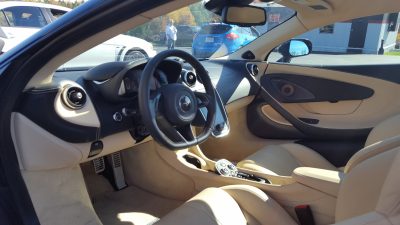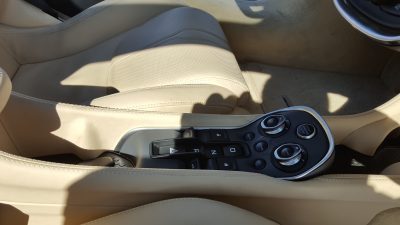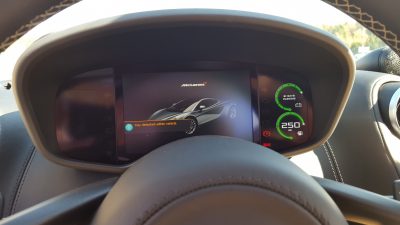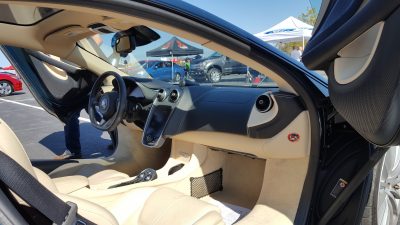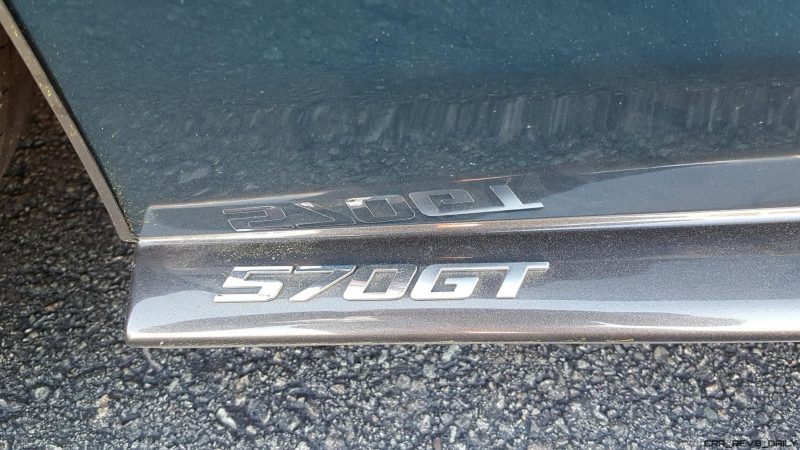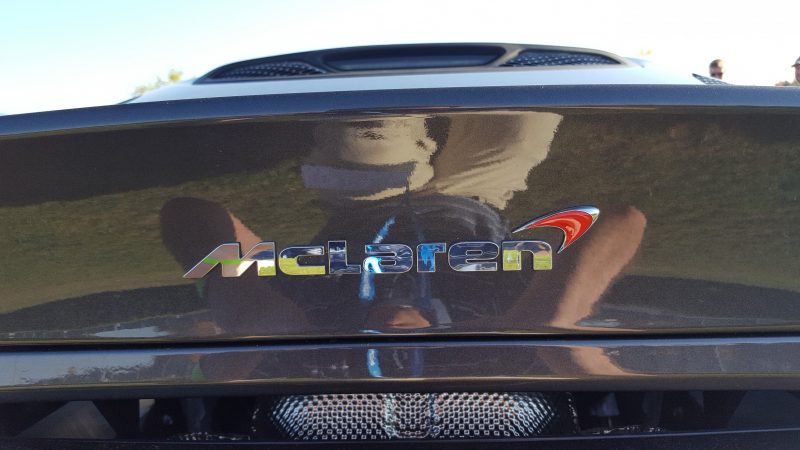VOLUME PLAY
When McLaren first unleashed its “sports” series of automobiles several years ago, they not only represented the British supercar company’s push to add higher levels of drivability and “day to day usability” to its potent vehicle offerings, but also the firm’s desire to greatly increase its sales volume over the next few years.
The 570S has certainly done a great job carving a niche for itself when compared to the pricier, and much-angrier 650S, thanks to its newfound levels of practicality as well as its lower pricing.
However McLaren is always striving to constantly outdo itself, and has unveiled the 2017 McLaren 570GT.
Aka, the Glassback!
I found myself at Monticello this week to try it out.
The 570GT is the closest that the brand has come to building a proper “grand touring” machine, but has its renewed levels of luxury and refinement caused the 570GT to lose the basic building blocks that define a proper McLaren offering?
The exterior styling of our Pacific Blue 570GT tester may appear to be virtually identical to the 570S at first glance, but a closer look at its seductive sheet metal reveals subtle differences that help make the 570GT standout when viewed side by side with its racier sibling.
For instance, many of its body panels been tweaked, though some of these changes require a careful eye to spot them. The lone exception is the chopped side sills which have been cut down slightly to help improve entry and exit for occupants. Having spent time in an older MP4-12C awhile back, this seemingly minor change does make a huge difference, especially for taller drivers that have long legs.
A key change is the new glass hatch that offers 7.8 cubic feet of cargo space. While this figure may seem a bit paltry at first glance, the 570GT still features a decently sized front trunk, and McLaren even offers specially shaped luggage that was designed to make full use of the limited space in the rear. As a bonus, the cargo space (AKA “Touring Deck” in McLaren speak) comes lined with supple leather, and houses several strategically placed baggage straps to help keep the bespoke luggage firmly secured.
The interior of our tester also shares much of its basic layout with the 570S, but McLaren designers made the atmosphere much more inviting with some of the exposed carbon fiber elements being pitched in lieu of more carpeting and soft touch materials. The seats are still on the firm side, but they are much more comfortable than before thanks in part to less aggressive bolstering, as well as the supple leather that adorns them.
There is generous legroom in the cabin, and the taller glass roof helps increase headroom while also letting in copious amounts of light.
However, this latter trait proved to be a double edged sword at times during my time with the car, and it sometimes caused information on the touchscreen interface to be washed out with glare, while also contributing to poor reflections on the front and rear window.
Hopefully, McLaren will eventually add a shade to help give occupants more control over how much light enters the cabin especially since many other GT offerings come equipped with such a feature.
Speaking of the touchscreen infotainment system, it is carried over from the 570S, and is a no frills affair that features a crisp display, which does a good job showing various bits of information. However, the system does have a brief learning curve, and there was occasional lag with select inputs. The equally configurable gauge cluster also carries over, and helps add some excitement to the overall driving experience thanks to the bold gauge readouts as well as the bright colors that adorn the cluster.
Despite the added levels of noise cancelling material as well as other GT exclusive elements, the 570GT will never be mistaken for a softie when it comes to what matters most. Performance for the 570GT comes from the familiar 3.8 liter mid-mounted twin-turbocharged V8 that also sees duty in the 570S, and is good for a healthy 562 horsepower and an equally potent 443 lb-ft of torque. The engine does have noticeable turbo lag in everyday commuting, and can feel quite lethargic at times. However rev the engine past 3,000 RPM, and it promptly wakes up to deliver on point acceleration, and provide an unforgettable soundtrack. All of this power is routed through a 7-speed dual clutch transmission that is also carried over from the 570S. Shifts are precise, but ironically the transmission also proves to be the biggest detractor to the GT experience that McLaren is trying to achieve with this car. This is due to the transmission’s tendency to hold onto gears for a bit too long. While this is good on a track, it also prevents the transmission from doing the quick up shifts that some buyers expect in a formal grand touring offering especially when commuting at more relaxed speeds.
Handling in the 570GT is also very secure and composed, and it proved to be a highlight for me during our time with the car. While a softer suspension may seem like a relatively minor alteration, it proved to be a key player in the driving experience with the car exhibiting better behavior over some of the rougher portions of New York State’s winding roads. There is a higher degree of composure and less clattering from the wheels, though the 570GT will never be mistaken for a formal luxury offering like the Cadillac CT6 and its ability to waft over most road imperfections. The steering is too numb in Normal mode, but that largely disappears when the suspension is shifted into Sport mode. When put into Sport mode, the steering does a good job rewarding driver input and helps the car flow through turns, while the pinpoint body reactions do a commendable job communicating the car’s attitude.
Like all McLaren offerings, there is also a built in Track mode to amp things up even further, but McLaren reps opted for safety, and asked us to not use it during our brief time in the 570GT. That’s fine with us, and in our opinion Track mode is simply not a good fit for this model, especially since the bulk of 570GT buyers will most likely do what we did during our time with the car, and keep it in Sport mode for the bulk of their commute.
Pricing for the 2017 McLaren 570GT reflects its higher levels of comfort and user friendliness while also ringing in as a $14,050 premium over the 570S that it is based on. The end result is a sticker of $201,450 with U.S. grade models like our car coming equipped with a rear view camera, and a specially designed nose lift system that helps the refined Brit enter certain parking garages without scraping the front splitter or worse, removing the entire front bumper. As expected from a car in its elite segment, 570GT owners can choose from a suite of pricey options including two different carbon fiber trim packs ($3,850 and $10,440 respectively, optional sport carbon-fiber seats, ($6,080) as well as the audiophile tuned Bowers & Wilkins sound system ($2,240).
So has the 570GT strayed too far from the McLaren formula? The answer is a solid no, but the 570GT does add a new dimension to the McLaren ownership experience, and we look forward to seeing what else is in store for McLaren’s growing supercar lineup.
Special thanks to McLaren for allowing us the opportunity to test and review the 570GT featured in this article.

Carl Malek has been an automotive journalist for over 10 years. First starting out as a freelance photographer before making the transition to writing during college, his work has appeared on numerous automotive forums as well as websites such as Autoshopper.com.
Carl is also a big fan of British vehicles with the bulk of his devotion going to the Morgan Motor Company as well as offerings from Lotus, MG, and Caterham. When he is not writing about automobiles, Carl enjoys spending time with his family and friends in the Metro Detroit area, as well as spending time with his adorable pets.






